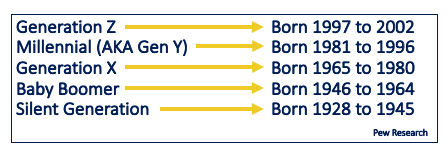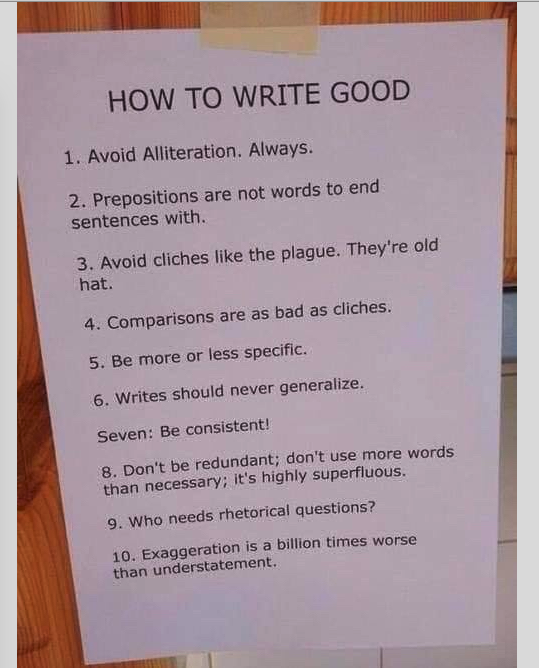Public relations is about telling the people (your publics) who you’re trying to educate, influence, sell to and engage about who you are and what you do. That’s why it’s important to understand the people (the P) in your PR plan. How people research, decide and spend their money and time is different depending on their age.
In January, Pew released a study on Millennials. That prompted me to do some research about myself (Gen X) and others. Here’s what the researchers have to say.

Generation Z: Born 1997 to 2002
- This group is late middle school, high school to college aged.
- My children are Generation Z.
- They think visually. They grew up using electronics, watching videos, transitioned to streaming.
- This is a tech dependent group with an attention span of about eight (yes 8) seconds.
- They like to try/see, collaborate, and have learning-centric opportunities with devices.
- By 2020 (next year), they’ll account for 40 percent of all consumers.
Millennial (AKA Gen Y): Born 1981 to 1996
According to a Pew study…
- Millennials are projected to number 73 million total this year overtaking Baby Boomers as the largest living adult generation.
- This group is smart (34 percent earned a bachelor’s degree).
- They’re getting married later (28-30 compared to 22 to 27 for the Silent Generation).
- And they’re more diverse with more women (72 percent) employed.
This is the consumer group I’m asked about the most.
- While they have debt (mostly due to paying for college), they have cash.
- Ages 25 to 37 in 2018 had a median adjusted household income of about $105,300 for those with a bachelor’s degree or higher, roughly $56,000 greater than that of households headed by high school graduates.
- Theyspend $600 billion a yearor around $85 per day.
- That’s 28 percent of the total daily per person consumer spending.
They aren’t influenced by brand. They’re influenced by social content.
- 83 percent of Millennials find online content useful in making purchasing decisions. [Source: Sharethrough]
- And they like coupons. Some 95 percent use coupons and have a preference for digitally using them.
- Millennials also cite an importance in giving back to the community and expect the brands they follow will do the same.
- Millennials spend more time on apps and the internet than they do watching television. [Source: Marketing Charts]
Generation X: Born 1965 to 1980
Bring on the buying power! This group is small but mighty.
According to American Express, Gen X has more spending power than any other generation.
- And they’re influential. They take care of aging parents while raising Gen Z (the youth with all of those electronics!).
- They say keep the content short, sweet and get to the point.
- Give me less text, more visual.
- People in this age group will research various channels to make a buying decision.
- And they expect customer service.
(In an effort to pay homage to them (and myself), we’re keeping this section short!)
But before we leave this generation, keep in mind us Gen Xers are, in fact, digitally savvy, despite what many marketers may think. A Millward Brown Digital, surveyed more than 1,000 consumers in three generations (Millennials, Generation X, and Baby Boomers):
- 60 percent of Gen Xers use a smartphone on a daily basis.
- 67 percent use a laptop/PC daily compared to 58 percent of Millennials.
We frequently go online for shopping, banking, research, digging for deals, and reading the news.
Baby Boomer: Born 1946 to 1964
- By next year there will be some 11 million more consumers over 60 years old.
- 90 percent are married-according to Pew.
- Baby Boomers are working longer. And they control 70 percent of the disposable income in America.
- And they too expect high levels of customer service.
- Some think people in this age group are resistant to online shopping-not true!
- For Boomers it’s a relaxing hobby-books, wine, household goods.
- According to a KPMG study:
- 66 percent of Boomers make regular purchases through online devices,
- and the large majority prefer to shop onlineusing a laptop or PC (67%) compared to a smartphone (4%) or tablet (10%).
- But keep in mind, according to KPMG, Boomers say they still like shopping in stores, 62 percent.
Silent Generation: Born 1928 to 1945
- This generation grew up during the Great Depression and WWII.
- Their behaviors are based on those experiences with a waste not want not attitude.
- They strive for comfort, quality and simplicity.


 Media pitch: Public relations teams are not literally pitching something at a reporter. We’re offering (or pitching) ideas based on editorial calendars and reporter beats.
Media pitch: Public relations teams are not literally pitching something at a reporter. We’re offering (or pitching) ideas based on editorial calendars and reporter beats. Public relations and communications plans take focus and consistency. Many business leaders work in companies with in-house marketing/communications professionals or own companies with outsourced marketing communications teams in place. Each month, these leaders review spreadsheets, P&Ls, balance sheets and other reports to be sure the business is financially healthy. Do those reports include marketing/communications dashboards? After all, isn’t it the marketing/communications that’s driving branding, new business, consumer purchases–your cash flow?
Public relations and communications plans take focus and consistency. Many business leaders work in companies with in-house marketing/communications professionals or own companies with outsourced marketing communications teams in place. Each month, these leaders review spreadsheets, P&Ls, balance sheets and other reports to be sure the business is financially healthy. Do those reports include marketing/communications dashboards? After all, isn’t it the marketing/communications that’s driving branding, new business, consumer purchases–your cash flow?